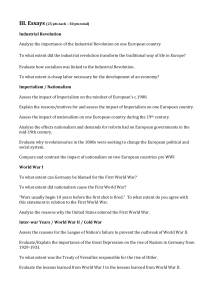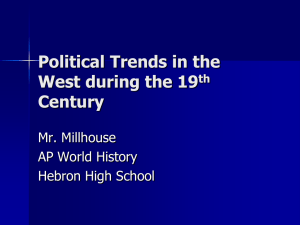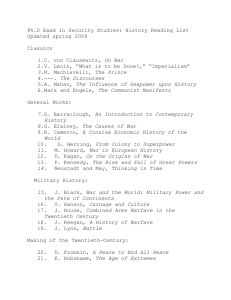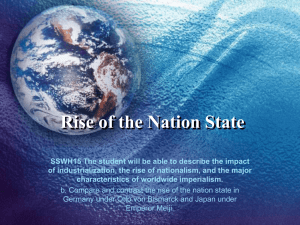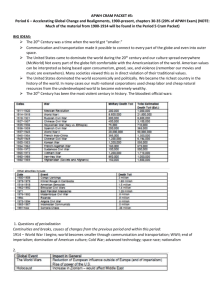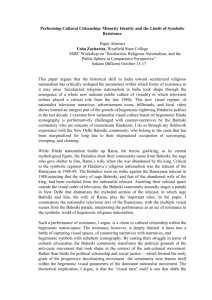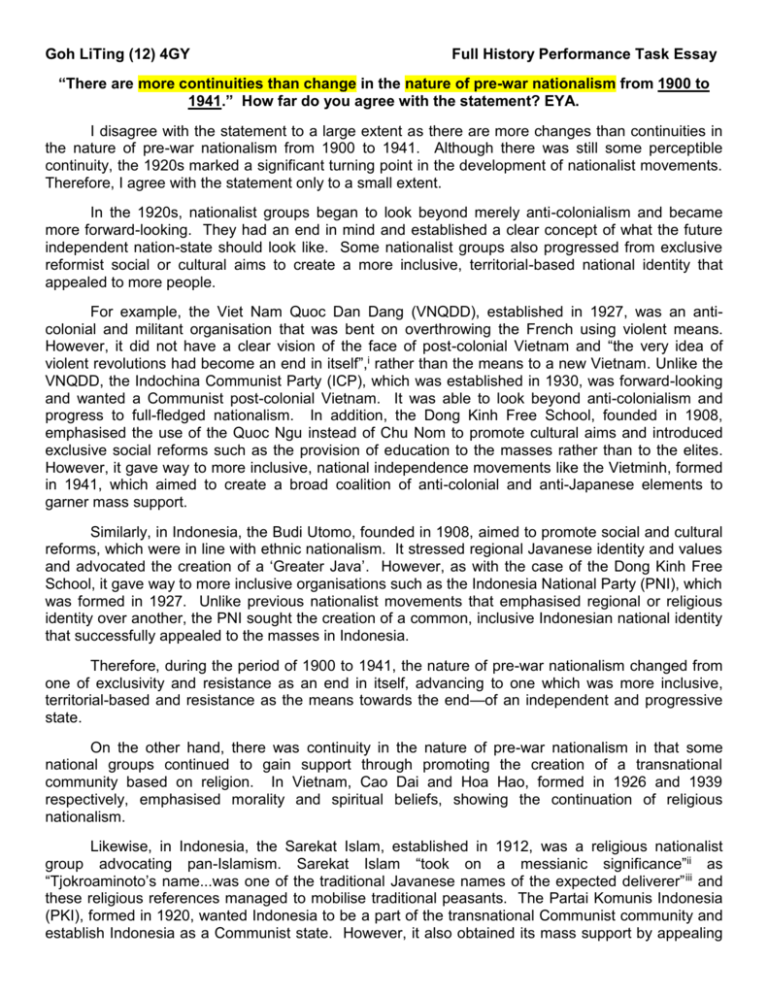
Goh LiTing (12) 4GY
Full History Performance Task Essay
“There are more continuities than change in the nature of pre-war nationalism from 1900 to
1941.” How far do you agree with the statement? EYA.
I disagree with the statement to a large extent as there are more changes than continuities in
the nature of pre-war nationalism from 1900 to 1941. Although there was still some perceptible
continuity, the 1920s marked a significant turning point in the development of nationalist movements.
Therefore, I agree with the statement only to a small extent.
In the 1920s, nationalist groups began to look beyond merely anti-colonialism and became
more forward-looking. They had an end in mind and established a clear concept of what the future
independent nation-state should look like. Some nationalist groups also progressed from exclusive
reformist social or cultural aims to create a more inclusive, territorial-based national identity that
appealed to more people.
For example, the Viet Nam Quoc Dan Dang (VNQDD), established in 1927, was an anticolonial and militant organisation that was bent on overthrowing the French using violent means.
However, it did not have a clear vision of the face of post-colonial Vietnam and “the very idea of
violent revolutions had become an end in itself”,i rather than the means to a new Vietnam. Unlike the
VNQDD, the Indochina Communist Party (ICP), which was established in 1930, was forward-looking
and wanted a Communist post-colonial Vietnam. It was able to look beyond anti-colonialism and
progress to full-fledged nationalism. In addition, the Dong Kinh Free School, founded in 1908,
emphasised the use of the Quoc Ngu instead of Chu Nom to promote cultural aims and introduced
exclusive social reforms such as the provision of education to the masses rather than to the elites.
However, it gave way to more inclusive, national independence movements like the Vietminh, formed
in 1941, which aimed to create a broad coalition of anti-colonial and anti-Japanese elements to
garner mass support.
Similarly, in Indonesia, the Budi Utomo, founded in 1908, aimed to promote social and cultural
reforms, which were in line with ethnic nationalism. It stressed regional Javanese identity and values
and advocated the creation of a ‘Greater Java’. However, as with the case of the Dong Kinh Free
School, it gave way to more inclusive organisations such as the Indonesia National Party (PNI), which
was formed in 1927. Unlike previous nationalist movements that emphasised regional or religious
identity over another, the PNI sought the creation of a common, inclusive Indonesian national identity
that successfully appealed to the masses in Indonesia.
Therefore, during the period of 1900 to 1941, the nature of pre-war nationalism changed from
one of exclusivity and resistance as an end in itself, advancing to one which was more inclusive,
territorial-based and resistance as the means towards the end—of an independent and progressive
state.
On the other hand, there was continuity in the nature of pre-war nationalism in that some
national groups continued to gain support through promoting the creation of a transnational
community based on religion. In Vietnam, Cao Dai and Hoa Hao, formed in 1926 and 1939
respectively, emphasised morality and spiritual beliefs, showing the continuation of religious
nationalism.
Likewise, in Indonesia, the Sarekat Islam, established in 1912, was a religious nationalist
group advocating pan-Islamism. Sarekat Islam “took on a messianic significance”ii as
“Tjokroaminoto’s name...was one of the traditional Javanese names of the expected deliverer” iii and
these religious references managed to mobilise traditional peasants. The Partai Komunis Indonesia
(PKI), formed in 1920, wanted Indonesia to be a part of the transnational Communist community and
establish Indonesia as a Communist state. However, it also obtained its mass support by appealing
to traditional beliefs in the supernatural—“The success of Socialist and Communist parties in
establishing mass memberships from the mid-1920s on can be attributed to the ‘adaptionists’ among
the organizers who allowed party principles to be carried by ‘traditional’, mainly religious, idioms of
protests.”iv Furthermore, during the PKI Revolt of 1926, the peasants were reportedly waving their
PKI membership booklets like amulets.v In Malaya, reformist Muslim groups such as the Kaum
Muda, formed in the early 1900s, also wanted to be a part of a pan-Indonesian Islamic community of
believers. Therefore, from 1900 to1941, there was also a measure of continuity as religion continued
to play a significant role in shaping the aims of nationalist groups.
In conclusion, although there was a small measure of continuity as religion still featured
strongly in the nature of pre-war nationalist groups, the period of the1920s was essentially a
watershed in the nature of nationalist movements. Many nationalist groups were increasingly able to
rise above exclusive regional identities and anti-colonialism to create a collective identity based on
territorial nationalism and the genuine desire for independence and not just to be rid of colonial rule.
Moreover, Communism emerged as a largely new force, having gained popularity after the Russian
Revolution in 1917, and leading to the creation of the ICP in Vietnam and the Malayan Communist
Party in Malaya, which were formed in 1930. Therefore, with the feature of Communism and the
advancement of nationalist groups to become more forward-looking, I agree only to a small extent
that there are more continuities than change in the nature of pre-war nationalism from 1900 to 1941.
899 words
Bibliography:
Yong, M. (2007) From Colonies to Independent Nations: Selected Studies in Southeast Asian
History. Singapore: Pearson Longman
Wong, H.H. (2010) Unit 3.1 Nationalism in S.E.A. 1900-1945. Singapore: SCGS
Wong, H.H. (2010) Anti-colonial Movements from 1850. Singapore: SCGS
Ileto, R. (1999) “Religion and Anti-colonial Movements” in Tarling, N. (ed.) The Cambridge
History of Southeast Asia: Vol 3, From 1800s to the 1930s. Cambridge: Cambridge University
Press.
i
Wong, H.H. (2010) Unit 3.1 Nationalism in S.E.A. 1900-1945: Vietnamese Nationalism. Singapore: SCGS
Wong, H.H. (2010) Unit 3.1 Nationalism in S.E.A. 1900-1945: Indonesian Nationalism. Singapore: SCGS
iii
Wong, H.H. (2010) Unit 3.1 Nationalism in S.E.A. 1900-1945: Indonesian Nationalism. Singapore: SCGS
iv
Wong, H.H. (2010) Anti-colonial Movements from 1850. Singapore: SCGS
v
Wong, H.H. (2010) Anti-colonial Movements from 1850. Singapore: SCGS
ii

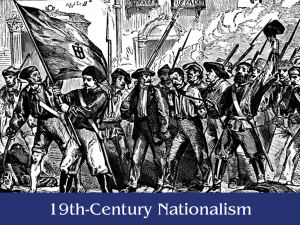
![“The Progress of invention is really a threat [to monarchy]. Whenever](http://s2.studylib.net/store/data/005328855_1-dcf2226918c1b7efad661cb19485529d-300x300.png)

